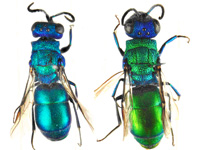Abstract
The girdled lizard genus Cordylus is represented in Angola by two species, Cordylus angolensis and C. machadoi, separated from their nearest congeners by over 700 km. Here we describe a new species, Cordylus namakuiyus sp. nov., endemic to the arid lowlands west of the southern Angolan escarpment. Phylogenetic analysis using three mitochondrial and eight nuclear genes shows that the low-elevation forms and the proximate, high-elevation species C. machadoi are genetically divergent and reciprocally monophyletic, and together form the earliest diverging lineage of the northern Cordylus clade. Morphological data, collected using computed tomography and traditional techniques (scalation and morphology), identify consistent phenotypic differences between these high- and low-elevation species and allows for a detailed description of the osteology and osteodermal arrangements of the new species. A series of 50 specimens, collected during the 1925 Vernay expedition to southwestern Angola and housed at the American Museum of Natural History, are assigned to the new species, although the identity of Cordylus from northern Namibia remains ambiguous and requires further investigation.
References
Bocage, J. (1895) Herpétologie d’Angola et du Congo. Imprimerie Nationale IXX: Lisbon, Lisbonne, 203 pp., 220 pls.
Branch, W.R. (1998) Field guide to snakes and other reptiles of southern Africa. Ralph Curtis Books Publishing: Sanibel Island, Florida, 399 pp.
Branch, W.R., Roedel, M.O. & Marais, J. (2005) A new species of rupicolous Cordylus Laurenti 1768 (Sauria: Cordylidae) from northern Mozambique. African Journal of Herpetology, 54, 131–138.
http://dx.doi.org/10.1080/21564574.2005.9635526Broadley, D.G. & Branch, W.R. (2002) A review of the small east African Cordylus (Sauria: Cordylidae), with the description of a new species. African Journal of Herpetology, 51, 9–34.
http://dx.doi.org/10.1080/21564574.2002.9635459Broadley, D.G. & Mouton, P.leF.N. (2000) A new species of rupicolous Cordylus Laurenti from Malawi (Sauria: Cordylidae). African Journal of Herpetology, 49 (2), 169–172
http://dx.doi.org/10.1080/21564574.2000.9635443
Conradie, W., Measey, G.J., Branch, W.R. & Tolley, K.A. (2012) Revised phylogeny of African sand lizards (Pedioplanis), with the description of two new species from south-western Angola. African Journal of Herpetology, 61 (2), 91–112.
http://dx.doi.org/10.1080/21564574.2012.676079Edgar, R. (2004) MUSCLE: a multiple sequence alignment method with reduced time and space complexity. BMC Bioinformatics, 19 (113), 1–19.
Felsenstein, J. (1985) Confidence limits on phylogenies: an approach using the bootstrap. Evolution, 39, 783–791.
http://dx.doi.org/10.2307/2408678Greenbaum, E., Stanley, E.L., Kusamba, C., Moninga, W.M., Goldberg, S.R. & Bursey, C.R. (2012) A new species of Cordylus (Squamata: Cordylidae) from the Marungu Plateau of south-eastern Democratic Republic of the Congo. African Journal of Herpetology, 61, 14–39.
http://dx.doi.org/10.1080/21564574.2012.666505Haacke, W.D. (2008) A new leaf-toed gecko (Reptilia: Gekkonidae) from south-western Angola. African Journal of Herpetology, 57 (2), 85–92.
http://dx.doi.org/10.1080/21564574.2008.9635571Huelsenbeck, J. & Ronquist, F. (2003) MrBayes: Bayesian Inference of Phylogeny. Bioinformatics, 17, 754–755.
http://dx.doi.org/10.1093/bioinformatics/17.8.754Huntley, B.J. (2009) SANBI/ISCED/UAN Angolan Biodiversity Assessment. Capacity Building Project. Report on Pilot Project March 2008 – February 2009. Unpublished report, South African National Biodiversity Institute, Kirstenbosch, Cape Town, 1–111.
Kearse, M., Moir, R., Wilson, A., Stones-Havas, S., Cheung, M., Sturrock, S., Buxton, S., Cooper, A., Markowitz, S., Duran, C., Thierer, T., Ashton, B., Mentjies, P. & Drummond, A. (2012) Geneious Basic: an integrated and extendable desktop software platform for the organization and analysis of sequence data. Bioinformatics, 28 (12), 1647–1649.
http://dx.doi.org/10.1093/bioinformatics/bts199Laurent, R. (1964) Reptiles et Amphibiens de l’Angola (Troisième contribution). — Companhia de Diamantes de Angola (Diamang). Serviços Culturais, Museu do Dundo (Angola), 67, 1–165.
Linder, H.P., de Klerk, H.M., Born, J., Burgess, N.D., Fjeldsta, J. & Rahbek, C. (2012) The partitioning of Africa: Statistically defined biogeographical regions in sub-Saharan Africa. Journal of Biogeography, 39, 1189–1205.
http://dx.doi.org/10.1111/j.1365-2699.2012.02728.xLoveridge, A. (1944) Revision of the African lizards of the family Cordylidae. Bulletin of the Museum of Comparative Zoology at Harvard College, 95 (195), 1–118.
Marques, M. (2015) Geographical distribution of the amphibians and reptiles of Angola. Unpublished Msc Thesis, University of Évora, Alentejo – NUTSII, 684 pp.
Monard, A. (1937) Contribution à l'herpetologie d'Angola. Archos. Museu Bocage (Lisboa), 8, 1–154.
Mouton, P. le F.N., Bates, M.F. & Whiting, M.J. (2014) Family Cordylidae. In: Bates, M.F., Branch, W.R., Bauer, A.M., Burger, M., Marais, J., Alexander, G.J. & de Villiers, M.S. (Eds.), Atlas and red list of the reptiles of South Africa, Lesotho and Swaziland. Suricata. Vol. 1. South African National Biodiversity Institute, Pretoria, pp. 182–223.
Nielsen, S.V. & Colston, T.J. (2014) The phylogenetic position of Ethiopia’s sole endemic and biogeographically enigmatic cordylid lizard, Cordylus rivae (Squamata: Cordylidae), and a discussion of its conservation status. African Journal of Herpetology, 63 (2), 166–176.
http://dx.doi.org/10.1080/21564574.2014.953606Nylander, J.A.A. (2008) MrModeltest 2.3. Program distributed by the author. Evolutionary Biology Centre, Uppsala University.
Stanley, E.L., Bauer, A.M., Jackman, T.R., Branch, W.R. & Mouton, P.leF.N. (2011) Between a rock and a hard polytomy: Rapid radiation in the rupicolous girdled lizards (Squamata: Cordylidae). Molecular Phylogenetics and Evolution, 58, 53–70.
http://dx.doi.org/10.1016/j.ympev.2010.08.024Swofford, D.L. (2002) Paup* Phylogenetic Analysis Using Parsimony (and Other Methods) Version 4.0. ed. Sunderland, Massachusetts.: Sinauer Associates.
Wiens, J.J., Kuczynski, C.A., Townsend, T., Reeder, T.W., Mulcahy, D.G. & Sites, J.W. (2010) Combining Phylogenomics and Fossils in Higher-Level Squamate Reptile Phylogeny: Molecular Data Change the Placement of Fossil Taxa. Systematic Biology, 59, 674–688.
http://dx.doi.org/10.1093/sysbio/syq048Zwickl, D.J. (2006) Genetic algorithm approaches for the phylogenetic analysis of large biological sequence datasets under the maximum likelihood criterion. Unpublished Ph.D. dissertation, The University of Texas, Austin, 115 pp.

